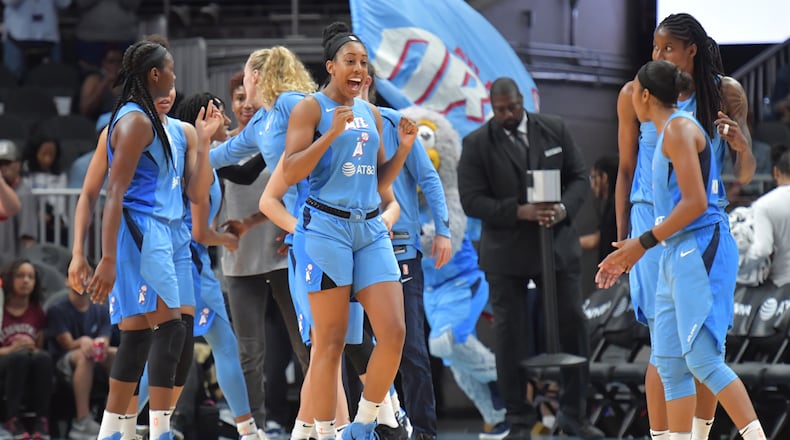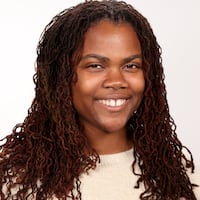The Dream’s front office is ready to plan for 2020. They just don’t know what they’ll be able to do quite yet.
The WNBA's current CBA is set to expire at the end of this month, and with it may go the current rules of business operations for the league. The CBA, which the players association opted out of in 2018 with a call to "bet on women," was set to expire Oct. 31, but was extended to the last day of 2019.
After a magical 2018 season that included a spot in the WNBA semifinals, the Dream won only eight games in 2019 and finished last in the league, as well as in points per game and field-goal percentage. WNBA’s 2018 Coach of the Year Nicki Collen and General Manager of the Year Chris Sienko already are working toward a better 2020.
The Dream has the No. 4 pick in the 2020 draft and more money to work with than 2019, when they had to deal with the effects of the season-ending injury two-time Olympian Angel McCoughtry suffered in 2018. McCoughtry missed the 2019 season, but had intentions to return, so her salary counted against the Dream’s cap and the Dream worked with 11 roster spots and the league limit of six players under guaranteed contracts, all earning above $100,000 or close to the league max of $117,500.
McCoughtry missed the entire 2019 season, but announced her intentions to return for the season finale, which was later determined to be a ceremonial appearance. In October, McCoughtry wrote in a tweet, "Atlanta! I'm grateful, thank you for allowing me to grow as a woman here!"
Both McCoughtry and Alex Bentley, who shot 30.4 percent from the field this season – the lowest of her career — are now unrestricted free agents.
The Atlanta Journal-Constitution asked Sienko whether the Dream planned to re-sign McCoughtry and Bentley, and he said, “We don’t even know what the CBA is, so I can’t tell you what we can or cannot do. I’m not at liberty to discuss what we’re going to do with personnel at this time.”
Four players on guaranteed contracts are set to return in 2020: Tiffany Hayes and Elizabeth Williams, who both signed multi-year extensions last year, and Breland and Renee Montgomery. The Dream have the option to sign two players to guaranteed, full-protection contracts.
Under the current CBA, the Dream have the option to “core” McCoughtry, despite her being a UFA (teams have “cored” with intentions to trade players or to keep a star player on the roster).
The Dream had the same pieces — minus one — to win games this past season. During the last five games of the Dream’s 12-game losing streak, they led going into the fourth quarter. In 2018, with McCoughtry, the team went undefeated in games decided by six points or less.
“As much as I felt like we were built to sustain not having Angel, if you look back at 2018, we had at least four games that were where we struggled to score early,” Collen said, “and Angel just carried us, not necessarily for four quarters, but maybe for a quarter and a half.”
There's also the option, according to High Post Hoops' WNBA salary database, for the Dream to utilize opened salary-cap space to sign someone who has the same level of fire as McCoughtry does. Or someone who can score, which would create space for a player like Tiffany Hayes to do Tiffany Hayes things with an open lane.
“If you ask Mike (Petersen) on my staff, we need to basically, draft players who can shoot, sign players who can shoot, and cut players who can’t shoot,” Collen said with a laugh.
But they can’t do anything until they know how the new CBA will work.
“What’s the cap going to be? How is this going to work?” Collen said, “We have this expectation our cap’s going to go up, but what other changes are being made and then within the increased cap assuming such happens, like, you know, are they increasing everybody's salary a percentage?”
And then there’s the draft.
A look at the future
The Dream will make their first lottery pick since choosing McCoughtry No. 1 a decade ago, and their highest since No. 7 in 2017 (Brittney Sykes).
But the draft, like the CBA, contains uncertainty.
The Dream securing the No. 1 pick would have made things easier, but WNBA lottery odds are determined by teams’ two-year records. After such a successful 2018, the Dream were given the worst odds to get the top pick, despite finishing last in 2019, and ended up with the fourth overall pick.
The draft could be shaped by draft-eligible players who could decide to leave college early (players such as Texas A&M’s Chennedy Carter and Oregon’s Satou Sabally, the latter Skylar Diggins-Smith has said was the most “pro-ready” player she faced on Team USA’s fall exhibition tour) or could decide to stay in school.
Draft night also remains important for a team’s success, according to Collen. The Dream’s draft history includes the drafting of an ineligible player in 2012 and trades for picks that other teams used for players such as 2019 WNBA Finals MVP Emma Meessemen and Chicago Sky all star Diamond DeShields.
Collen mentions top teams in the league – Vegas, Seattle, Phoenix, teams with multiple No. 1 draft picks and Washington, Minnesota, teams that benefited from forced trades by high draft picks. L.A. Sparks have both. She considers her former team Connecticut Sun, who made the 2019 WNBA Finals for the first time since 2005, more of an outlier – a young team that grew up together.
The Dream franchise has only had one No. 1 pick, McCoughtry, and has two No. 4 picks Montgomery (2009) and Williams (2013), who were drafted by other teams. Alaina Coates, who the Dream signed late during the 2019 season, was drafted No. 2 in 2017 but averaged only 8.3 minutes in nine games for Atlanta.
In 2019 the Dream’s first pick came at No. 11. To prepare for free agency and the draft, despite all the unknowns, Collen is weighing all the draft options.
“You have to study players, and you have to study their personalities. You can't just be an analytics nerd and say, like, OK, ‘I’m taking her because,’” Collen said. “There has to be the eye test, there has to be the character test. Like, there's all these like factors that go into making decisions.”
She’s, of course, also watching a ton of basketball – she watched Team USA’s fall exhibitions, FIBA pre-olympic qualifying, college games, Dream players overseas, NBA. She’ll even be going to college games in person once the better/conference matchups begin.
“You know, you can there are things you can pick up in person from, or in a practice setting, how they verbalize things, are they good communicators, you’re never going to get on video, you can talk to their coaches, but, you know, I want to hear a post player yelling screen right and I want to hear them like articulate it over and over again.”
Collen is excited, and as much as she said she dislikes not being able to truly begin to prepare for 2020, she calls the various scenarios, possible outcomes fun. The entire front office are weighing their options until a new plan can be put into place once one piece of the puzzle, the new CBA, is announced.
“We’re assessing our athletes, we're assessing new athletes, we’re looking at other players around the league,” Sienko said. “Are there things that we can we can do to trade to make our team stronger? Are there assets that other teams may want of ours? And that’s typical, every single team does the same thing. At the end of the day. I think people have to understand this is a business, and we're doing everything we can to win a championship.”
About the Author
Keep Reading
The Latest
Featured



